Comprehensive Security Analysis: Time Series, Risk, and Returns
VerifiedAdded on 2020/03/16
|11
|1769
|40
Homework Assignment
AI Summary
This document presents a comprehensive security analysis, addressing various aspects of financial data analysis. It begins with time series graphs for the S&P 500, Boeing Company (BA), and IBM, examining trends, seasonality, and outliers. The analysis then delves into return calculations, summary...
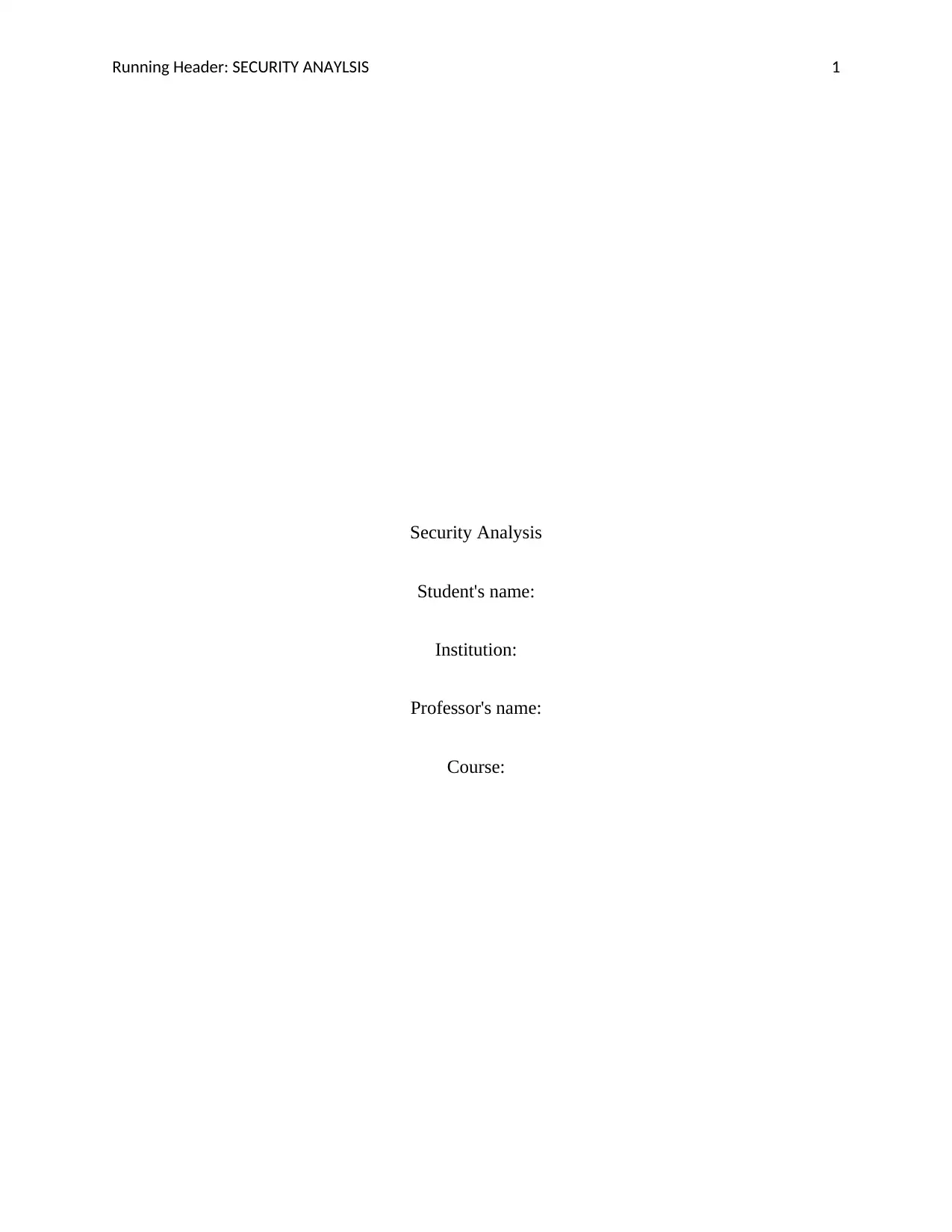
Running Header: SECURITY ANAYLSIS 1
Security Analysis
Student's name:
Institution:
Professor's name:
Course:
Security Analysis
Student's name:
Institution:
Professor's name:
Course:
Paraphrase This Document
Need a fresh take? Get an instant paraphrase of this document with our AI Paraphraser
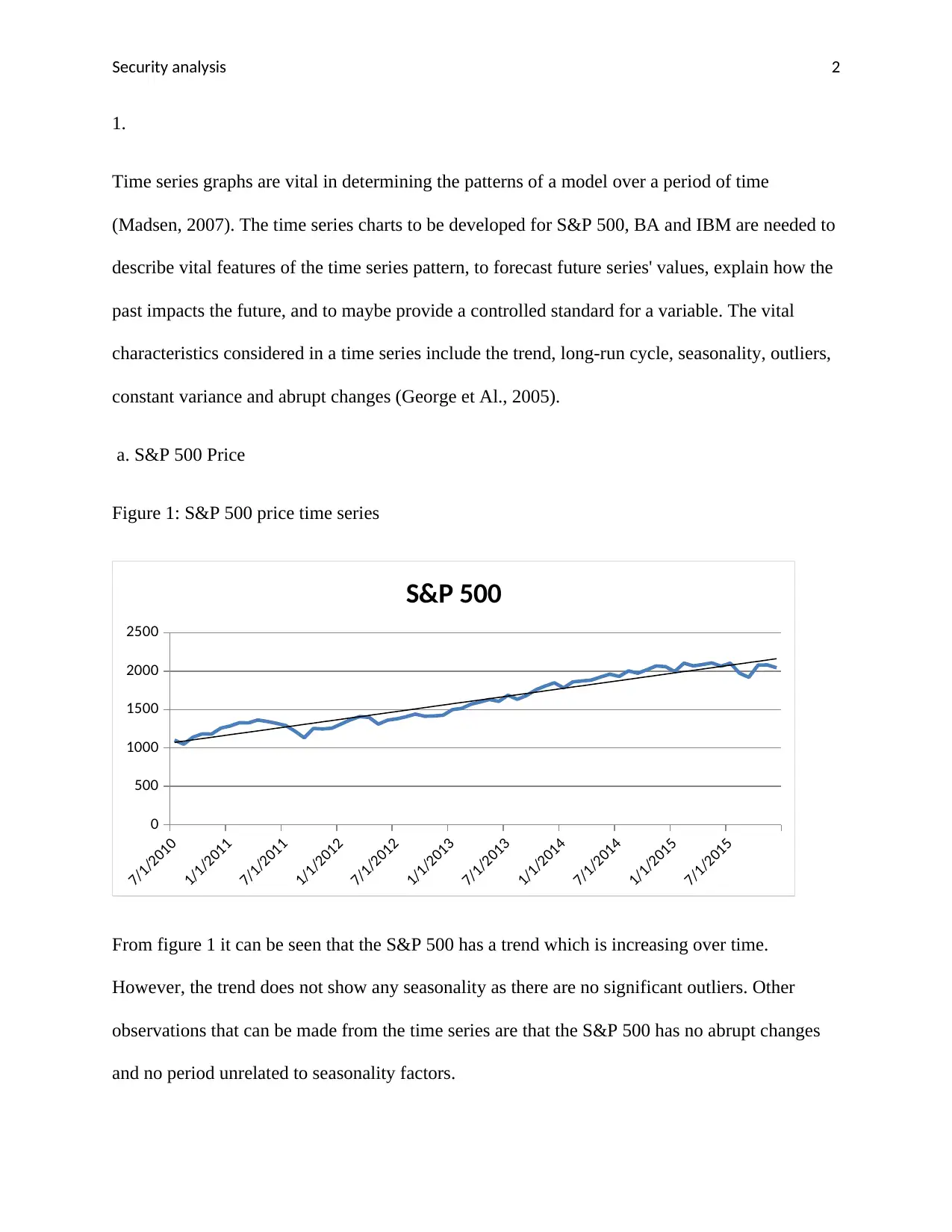
Security analysis 2
1.
Time series graphs are vital in determining the patterns of a model over a period of time
(Madsen, 2007). The time series charts to be developed for S&P 500, BA and IBM are needed to
describe vital features of the time series pattern, to forecast future series' values, explain how the
past impacts the future, and to maybe provide a controlled standard for a variable. The vital
characteristics considered in a time series include the trend, long-run cycle, seasonality, outliers,
constant variance and abrupt changes (George et Al., 2005).
a. S&P 500 Price
Figure 1: S&P 500 price time series
7/1/2010
1/1/2011
7/1/2011
1/1/2012
7/1/2012
1/1/2013
7/1/2013
1/1/2014
7/1/2014
1/1/2015
7/1/2015
0
500
1000
1500
2000
2500
S&P 500
From figure 1 it can be seen that the S&P 500 has a trend which is increasing over time.
However, the trend does not show any seasonality as there are no significant outliers. Other
observations that can be made from the time series are that the S&P 500 has no abrupt changes
and no period unrelated to seasonality factors.
1.
Time series graphs are vital in determining the patterns of a model over a period of time
(Madsen, 2007). The time series charts to be developed for S&P 500, BA and IBM are needed to
describe vital features of the time series pattern, to forecast future series' values, explain how the
past impacts the future, and to maybe provide a controlled standard for a variable. The vital
characteristics considered in a time series include the trend, long-run cycle, seasonality, outliers,
constant variance and abrupt changes (George et Al., 2005).
a. S&P 500 Price
Figure 1: S&P 500 price time series
7/1/2010
1/1/2011
7/1/2011
1/1/2012
7/1/2012
1/1/2013
7/1/2013
1/1/2014
7/1/2014
1/1/2015
7/1/2015
0
500
1000
1500
2000
2500
S&P 500
From figure 1 it can be seen that the S&P 500 has a trend which is increasing over time.
However, the trend does not show any seasonality as there are no significant outliers. Other
observations that can be made from the time series are that the S&P 500 has no abrupt changes
and no period unrelated to seasonality factors.
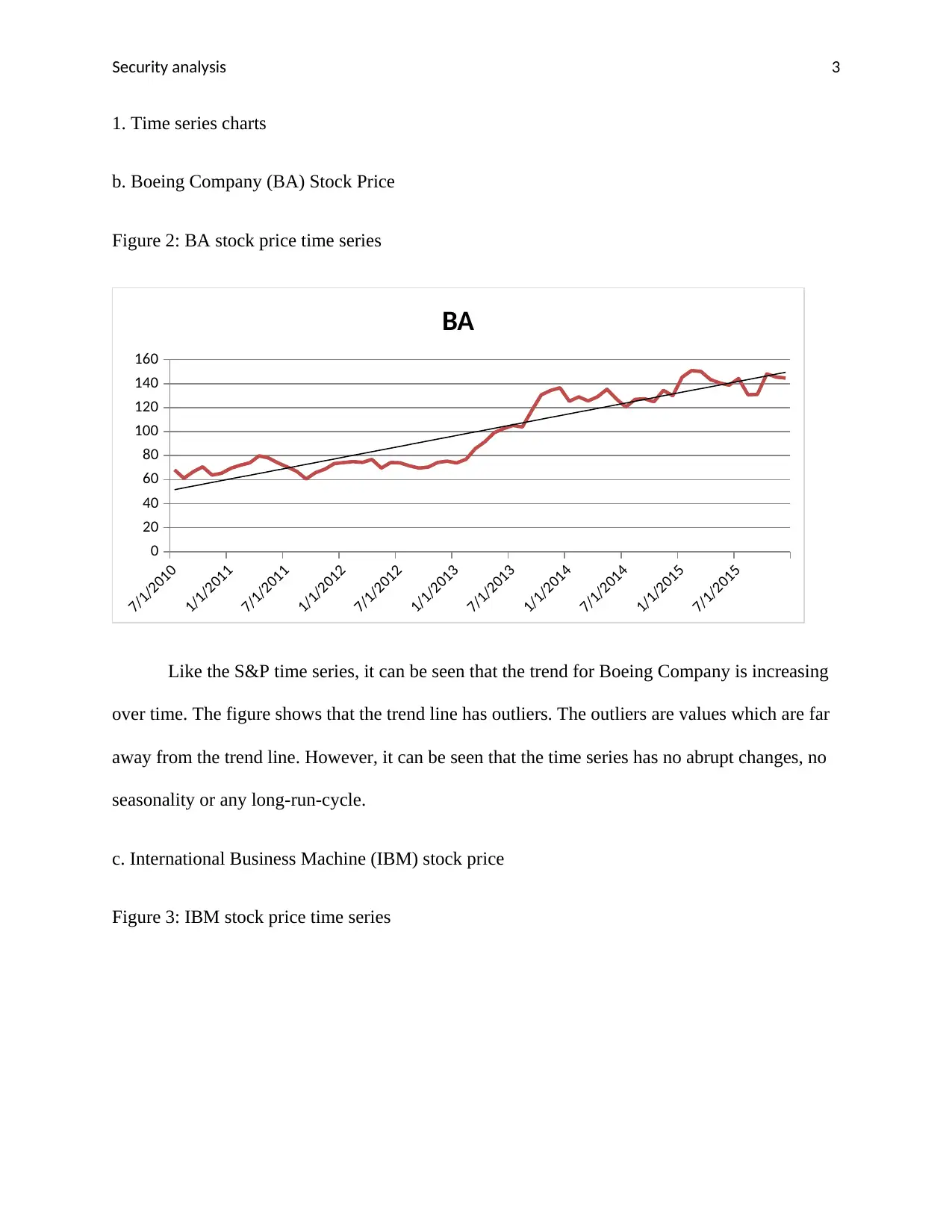
Security analysis 3
1. Time series charts
b. Boeing Company (BA) Stock Price
Figure 2: BA stock price time series
7/1/2010
1/1/2011
7/1/2011
1/1/2012
7/1/2012
1/1/2013
7/1/2013
1/1/2014
7/1/2014
1/1/2015
7/1/2015
0
20
40
60
80
100
120
140
160
BA
Like the S&P time series, it can be seen that the trend for Boeing Company is increasing
over time. The figure shows that the trend line has outliers. The outliers are values which are far
away from the trend line. However, it can be seen that the time series has no abrupt changes, no
seasonality or any long-run-cycle.
c. International Business Machine (IBM) stock price
Figure 3: IBM stock price time series
1. Time series charts
b. Boeing Company (BA) Stock Price
Figure 2: BA stock price time series
7/1/2010
1/1/2011
7/1/2011
1/1/2012
7/1/2012
1/1/2013
7/1/2013
1/1/2014
7/1/2014
1/1/2015
7/1/2015
0
20
40
60
80
100
120
140
160
BA
Like the S&P time series, it can be seen that the trend for Boeing Company is increasing
over time. The figure shows that the trend line has outliers. The outliers are values which are far
away from the trend line. However, it can be seen that the time series has no abrupt changes, no
seasonality or any long-run-cycle.
c. International Business Machine (IBM) stock price
Figure 3: IBM stock price time series
⊘ This is a preview!⊘
Do you want full access?
Subscribe today to unlock all pages.

Trusted by 1+ million students worldwide
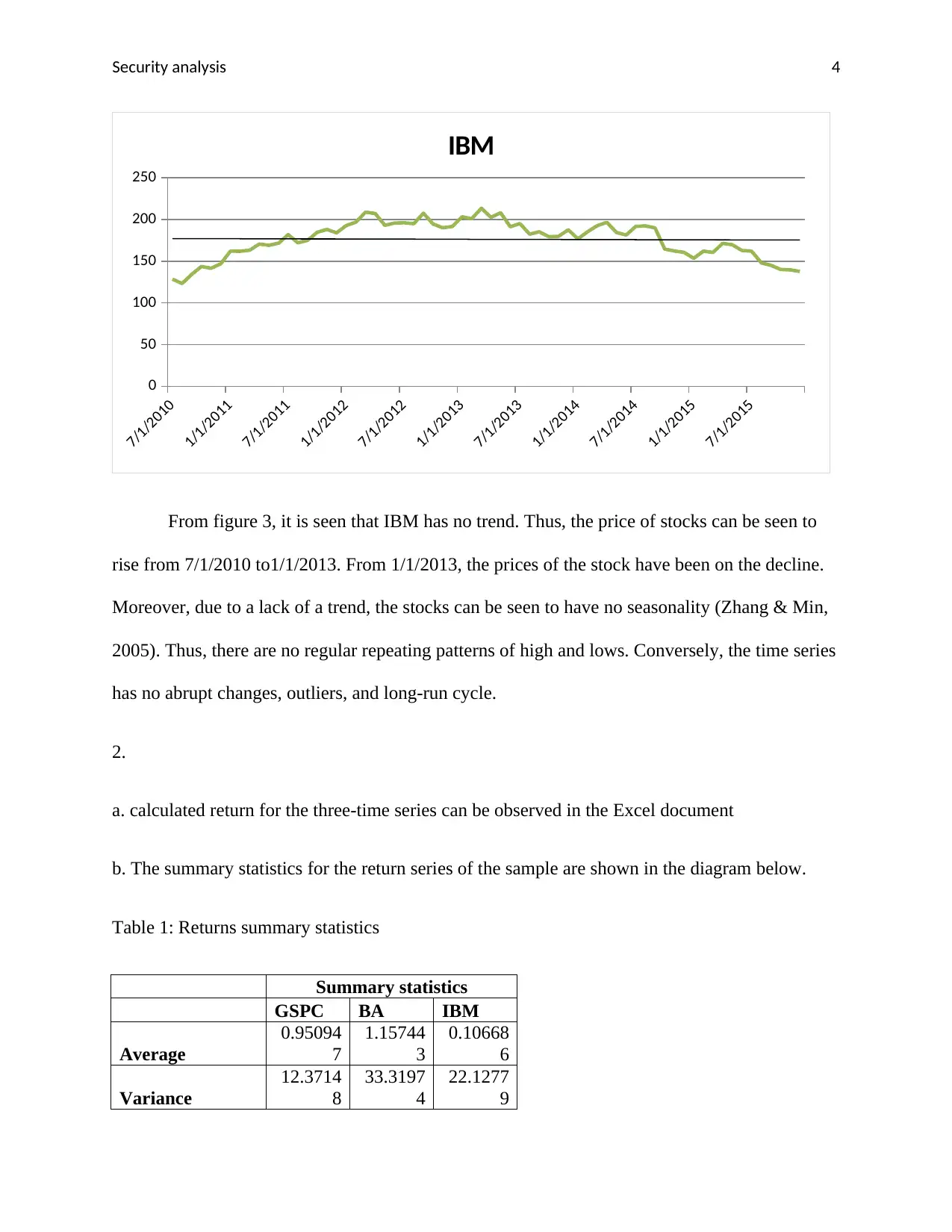
Security analysis 4
7/1/2010
1/1/2011
7/1/2011
1/1/2012
7/1/2012
1/1/2013
7/1/2013
1/1/2014
7/1/2014
1/1/2015
7/1/2015
0
50
100
150
200
250
IBM
From figure 3, it is seen that IBM has no trend. Thus, the price of stocks can be seen to
rise from 7/1/2010 to1/1/2013. From 1/1/2013, the prices of the stock have been on the decline.
Moreover, due to a lack of a trend, the stocks can be seen to have no seasonality (Zhang & Min,
2005). Thus, there are no regular repeating patterns of high and lows. Conversely, the time series
has no abrupt changes, outliers, and long-run cycle.
2.
a. calculated return for the three-time series can be observed in the Excel document
b. The summary statistics for the return series of the sample are shown in the diagram below.
Table 1: Returns summary statistics
Summary statistics
GSPC BA IBM
Average
0.95094
7
1.15744
3
0.10668
6
Variance
12.3714
8
33.3197
4
22.1277
9
7/1/2010
1/1/2011
7/1/2011
1/1/2012
7/1/2012
1/1/2013
7/1/2013
1/1/2014
7/1/2014
1/1/2015
7/1/2015
0
50
100
150
200
250
IBM
From figure 3, it is seen that IBM has no trend. Thus, the price of stocks can be seen to
rise from 7/1/2010 to1/1/2013. From 1/1/2013, the prices of the stock have been on the decline.
Moreover, due to a lack of a trend, the stocks can be seen to have no seasonality (Zhang & Min,
2005). Thus, there are no regular repeating patterns of high and lows. Conversely, the time series
has no abrupt changes, outliers, and long-run cycle.
2.
a. calculated return for the three-time series can be observed in the Excel document
b. The summary statistics for the return series of the sample are shown in the diagram below.
Table 1: Returns summary statistics
Summary statistics
GSPC BA IBM
Average
0.95094
7
1.15744
3
0.10668
6
Variance
12.3714
8
33.3197
4
22.1277
9
Paraphrase This Document
Need a fresh take? Get an instant paraphrase of this document with our AI Paraphraser
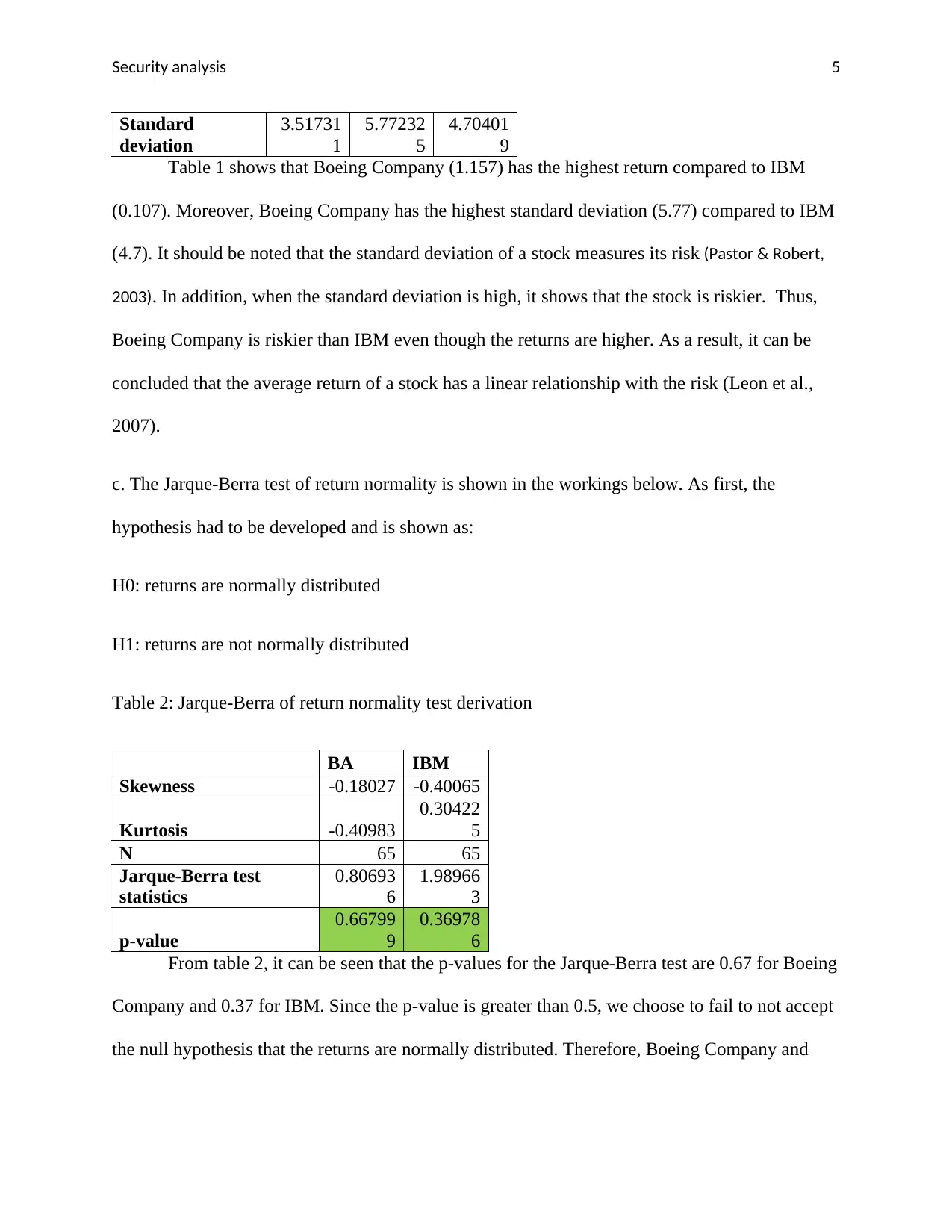
Security analysis 5
Standard
deviation
3.51731
1
5.77232
5
4.70401
9
Table 1 shows that Boeing Company (1.157) has the highest return compared to IBM
(0.107). Moreover, Boeing Company has the highest standard deviation (5.77) compared to IBM
(4.7). It should be noted that the standard deviation of a stock measures its risk (Pastor & Robert,
2003). In addition, when the standard deviation is high, it shows that the stock is riskier. Thus,
Boeing Company is riskier than IBM even though the returns are higher. As a result, it can be
concluded that the average return of a stock has a linear relationship with the risk (Leon et al.,
2007).
c. The Jarque-Berra test of return normality is shown in the workings below. As first, the
hypothesis had to be developed and is shown as:
H0: returns are normally distributed
H1: returns are not normally distributed
Table 2: Jarque-Berra of return normality test derivation
BA IBM
Skewness -0.18027 -0.40065
Kurtosis -0.40983
0.30422
5
N 65 65
Jarque-Berra test
statistics
0.80693
6
1.98966
3
p-value
0.66799
9
0.36978
6
From table 2, it can be seen that the p-values for the Jarque-Berra test are 0.67 for Boeing
Company and 0.37 for IBM. Since the p-value is greater than 0.5, we choose to fail to not accept
the null hypothesis that the returns are normally distributed. Therefore, Boeing Company and
Standard
deviation
3.51731
1
5.77232
5
4.70401
9
Table 1 shows that Boeing Company (1.157) has the highest return compared to IBM
(0.107). Moreover, Boeing Company has the highest standard deviation (5.77) compared to IBM
(4.7). It should be noted that the standard deviation of a stock measures its risk (Pastor & Robert,
2003). In addition, when the standard deviation is high, it shows that the stock is riskier. Thus,
Boeing Company is riskier than IBM even though the returns are higher. As a result, it can be
concluded that the average return of a stock has a linear relationship with the risk (Leon et al.,
2007).
c. The Jarque-Berra test of return normality is shown in the workings below. As first, the
hypothesis had to be developed and is shown as:
H0: returns are normally distributed
H1: returns are not normally distributed
Table 2: Jarque-Berra of return normality test derivation
BA IBM
Skewness -0.18027 -0.40065
Kurtosis -0.40983
0.30422
5
N 65 65
Jarque-Berra test
statistics
0.80693
6
1.98966
3
p-value
0.66799
9
0.36978
6
From table 2, it can be seen that the p-values for the Jarque-Berra test are 0.67 for Boeing
Company and 0.37 for IBM. Since the p-value is greater than 0.5, we choose to fail to not accept
the null hypothesis that the returns are normally distributed. Therefore, Boeing Company and
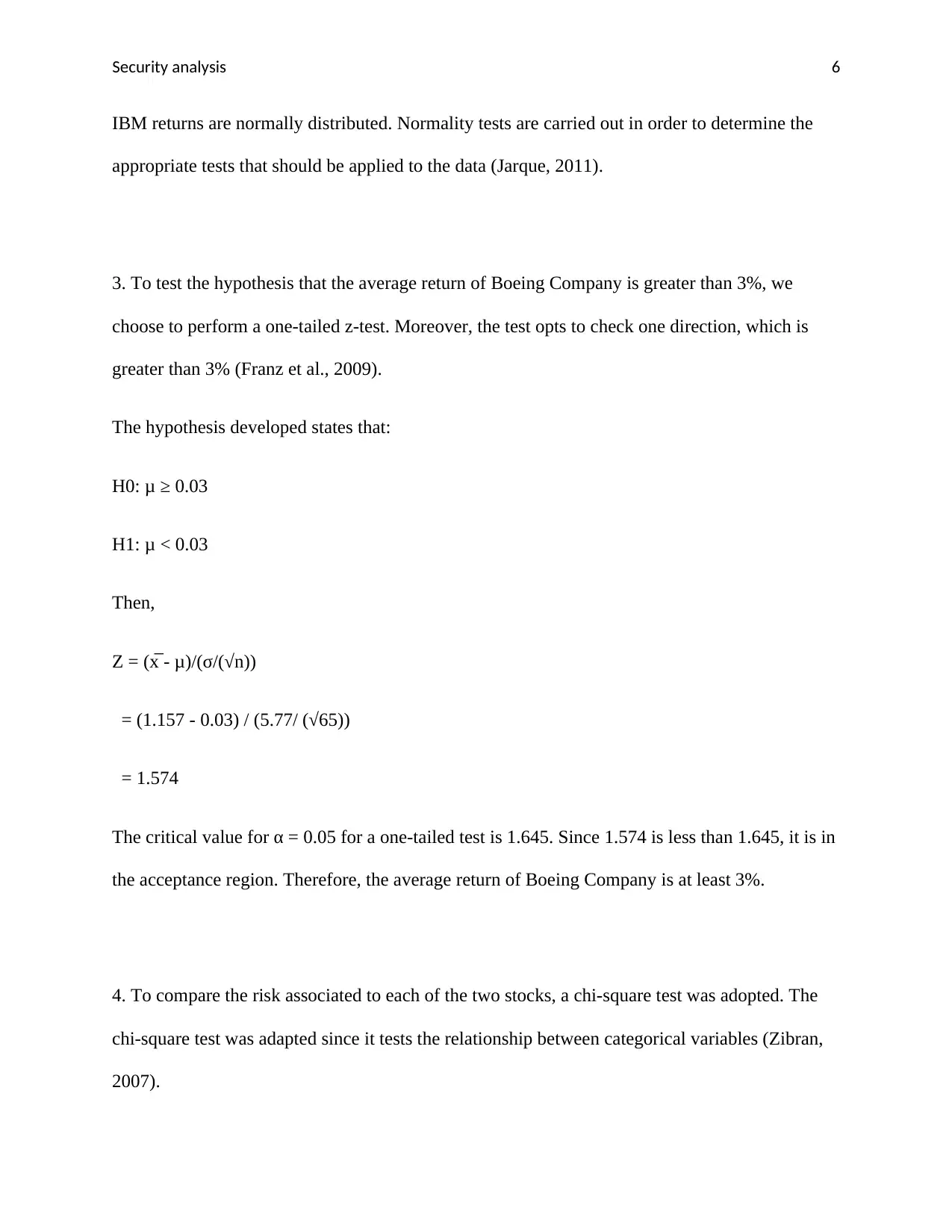
Security analysis 6
IBM returns are normally distributed. Normality tests are carried out in order to determine the
appropriate tests that should be applied to the data (Jarque, 2011).
3. To test the hypothesis that the average return of Boeing Company is greater than 3%, we
choose to perform a one-tailed z-test. Moreover, the test opts to check one direction, which is
greater than 3% (Franz et al., 2009).
The hypothesis developed states that:
H0: μ ≥ 0.03
H1: μ < 0.03
Then,
Z = (x̅ - μ)/(σ/(√n))
= (1.157 - 0.03) / (5.77/ (√65))
= 1.574
The critical value for α = 0.05 for a one-tailed test is 1.645. Since 1.574 is less than 1.645, it is in
the acceptance region. Therefore, the average return of Boeing Company is at least 3%.
4. To compare the risk associated to each of the two stocks, a chi-square test was adopted. The
chi-square test was adapted since it tests the relationship between categorical variables (Zibran,
2007).
IBM returns are normally distributed. Normality tests are carried out in order to determine the
appropriate tests that should be applied to the data (Jarque, 2011).
3. To test the hypothesis that the average return of Boeing Company is greater than 3%, we
choose to perform a one-tailed z-test. Moreover, the test opts to check one direction, which is
greater than 3% (Franz et al., 2009).
The hypothesis developed states that:
H0: μ ≥ 0.03
H1: μ < 0.03
Then,
Z = (x̅ - μ)/(σ/(√n))
= (1.157 - 0.03) / (5.77/ (√65))
= 1.574
The critical value for α = 0.05 for a one-tailed test is 1.645. Since 1.574 is less than 1.645, it is in
the acceptance region. Therefore, the average return of Boeing Company is at least 3%.
4. To compare the risk associated to each of the two stocks, a chi-square test was adopted. The
chi-square test was adapted since it tests the relationship between categorical variables (Zibran,
2007).
⊘ This is a preview!⊘
Do you want full access?
Subscribe today to unlock all pages.

Trusted by 1+ million students worldwide

Security analysis 7
Thus,
H0: σ1 = σ2
H1: σ1 ≠ σ2
α = 0.05
Numerator degree of freedom = 65 - 1 = 64
Denominator degree of freedom = 65 -1 = 64
F = σ2 1
σ2 2 = 33.32 / 22.13 = 1.506
Critical values: F (0.975, 64, 64) = 0.54
F (0.025, 64, 64) =1.0
Rejection region: Reject H0 if F < 0.54 or F > 1.0
Thus, there is enough evidence to not accept the null hypothesis since the F statistic is within the
acceptance region. Therefore, the risks associated with the stock are similar to each other.
5. To determine whether the population average returns are equal, an ANOVA analysis was
chosen. The results of the ANOVA analysis are shown below:
H0: Population average returns are equal
H1: Population average returns are not equal
Thus,
H0: σ1 = σ2
H1: σ1 ≠ σ2
α = 0.05
Numerator degree of freedom = 65 - 1 = 64
Denominator degree of freedom = 65 -1 = 64
F = σ2 1
σ2 2 = 33.32 / 22.13 = 1.506
Critical values: F (0.975, 64, 64) = 0.54
F (0.025, 64, 64) =1.0
Rejection region: Reject H0 if F < 0.54 or F > 1.0
Thus, there is enough evidence to not accept the null hypothesis since the F statistic is within the
acceptance region. Therefore, the risks associated with the stock are similar to each other.
5. To determine whether the population average returns are equal, an ANOVA analysis was
chosen. The results of the ANOVA analysis are shown below:
H0: Population average returns are equal
H1: Population average returns are not equal
Paraphrase This Document
Need a fresh take? Get an instant paraphrase of this document with our AI Paraphraser
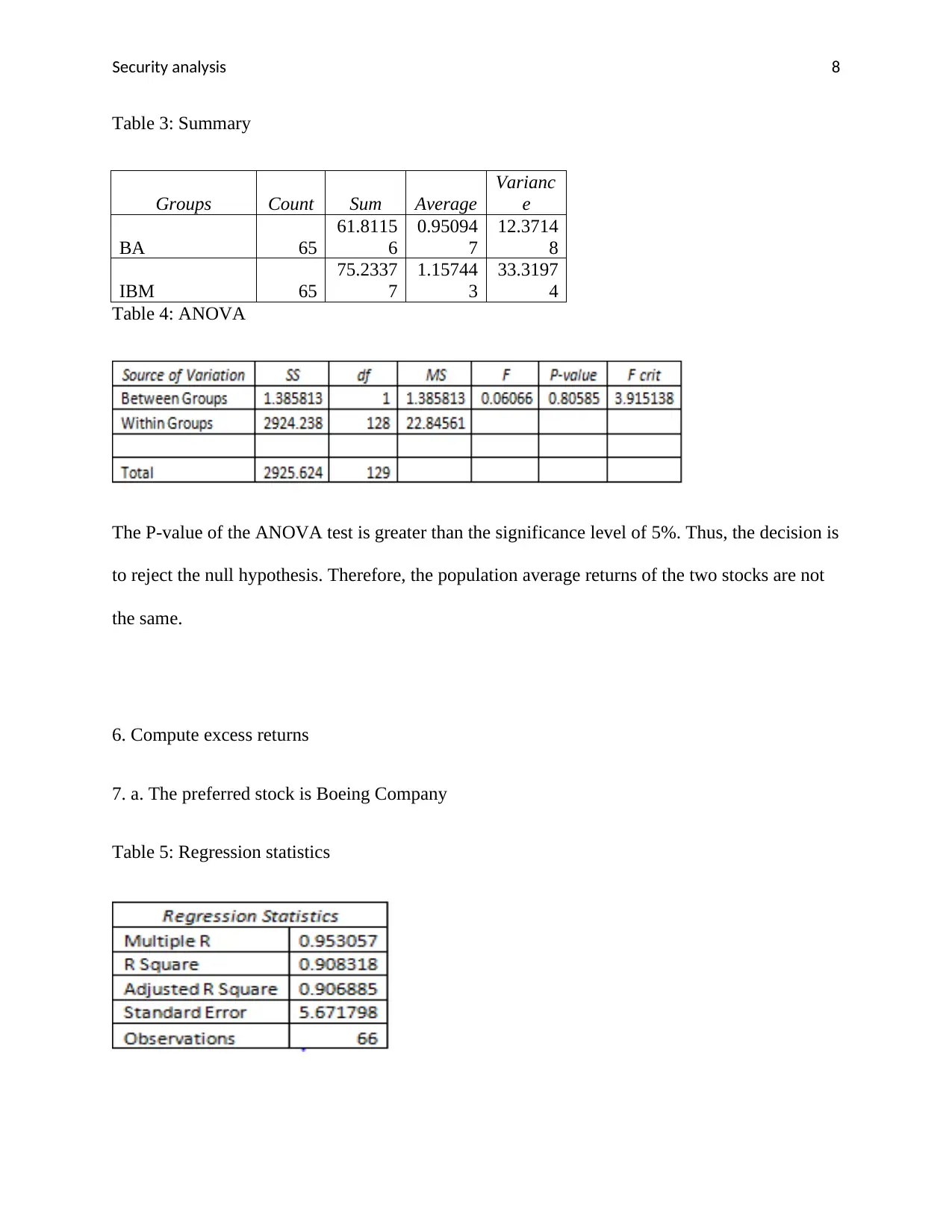
Security analysis 8
Table 3: Summary
Groups Count Sum Average
Varianc
e
BA 65
61.8115
6
0.95094
7
12.3714
8
IBM 65
75.2337
7
1.15744
3
33.3197
4
Table 4: ANOVA
The P-value of the ANOVA test is greater than the significance level of 5%. Thus, the decision is
to reject the null hypothesis. Therefore, the population average returns of the two stocks are not
the same.
6. Compute excess returns
7. a. The preferred stock is Boeing Company
Table 5: Regression statistics
Table 3: Summary
Groups Count Sum Average
Varianc
e
BA 65
61.8115
6
0.95094
7
12.3714
8
IBM 65
75.2337
7
1.15744
3
33.3197
4
Table 4: ANOVA
The P-value of the ANOVA test is greater than the significance level of 5%. Thus, the decision is
to reject the null hypothesis. Therefore, the population average returns of the two stocks are not
the same.
6. Compute excess returns
7. a. The preferred stock is Boeing Company
Table 5: Regression statistics
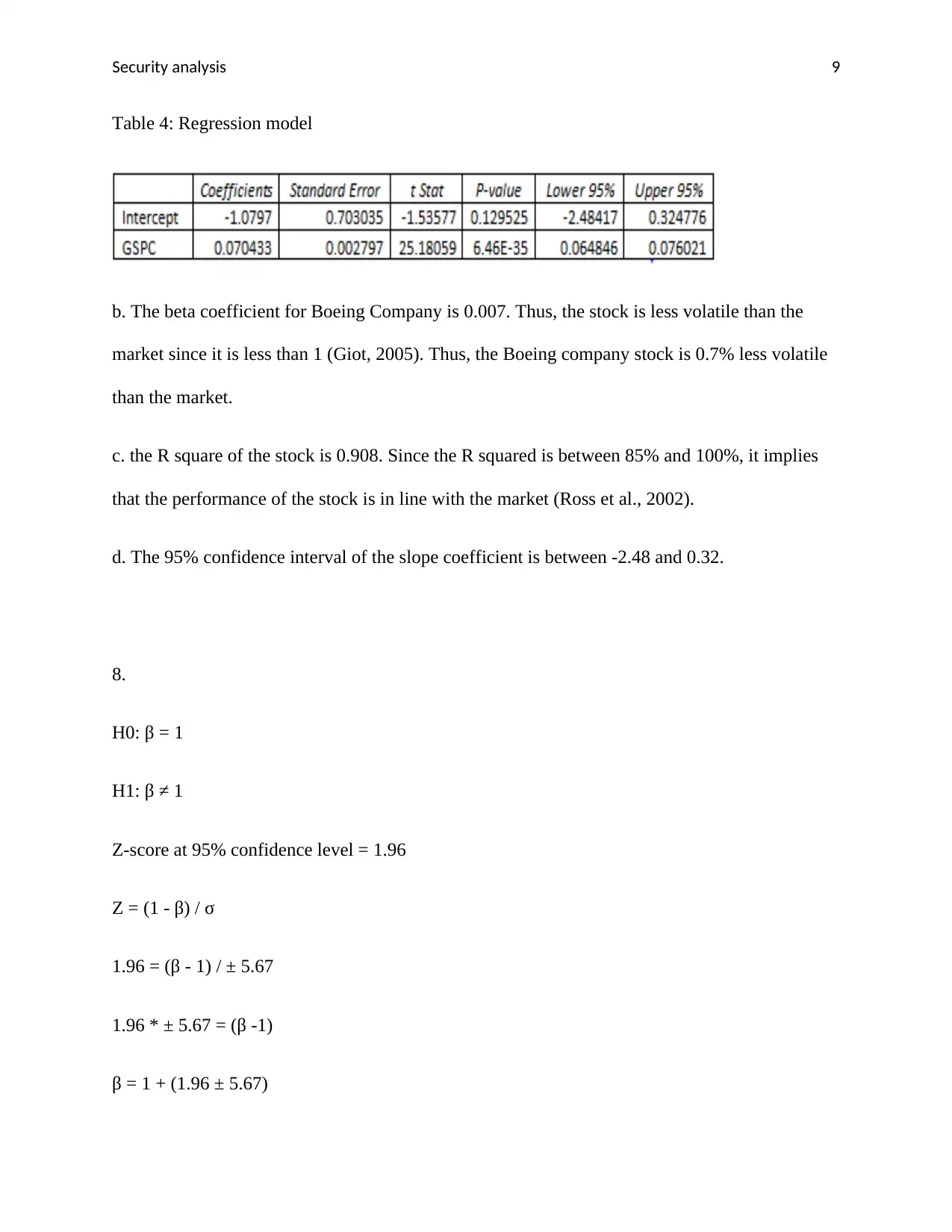
Security analysis 9
Table 4: Regression model
b. The beta coefficient for Boeing Company is 0.007. Thus, the stock is less volatile than the
market since it is less than 1 (Giot, 2005). Thus, the Boeing company stock is 0.7% less volatile
than the market.
c. the R square of the stock is 0.908. Since the R squared is between 85% and 100%, it implies
that the performance of the stock is in line with the market (Ross et al., 2002).
d. The 95% confidence interval of the slope coefficient is between -2.48 and 0.32.
8.
H0: β = 1
H1: β ≠ 1
Z-score at 95% confidence level = 1.96
Z = (1 - β) / σ
1.96 = (β - 1) / ± 5.67
1.96 * ± 5.67 = (β -1)
β = 1 + (1.96 ± 5.67)
Table 4: Regression model
b. The beta coefficient for Boeing Company is 0.007. Thus, the stock is less volatile than the
market since it is less than 1 (Giot, 2005). Thus, the Boeing company stock is 0.7% less volatile
than the market.
c. the R square of the stock is 0.908. Since the R squared is between 85% and 100%, it implies
that the performance of the stock is in line with the market (Ross et al., 2002).
d. The 95% confidence interval of the slope coefficient is between -2.48 and 0.32.
8.
H0: β = 1
H1: β ≠ 1
Z-score at 95% confidence level = 1.96
Z = (1 - β) / σ
1.96 = (β - 1) / ± 5.67
1.96 * ± 5.67 = (β -1)
β = 1 + (1.96 ± 5.67)
⊘ This is a preview!⊘
Do you want full access?
Subscribe today to unlock all pages.

Trusted by 1+ million students worldwide
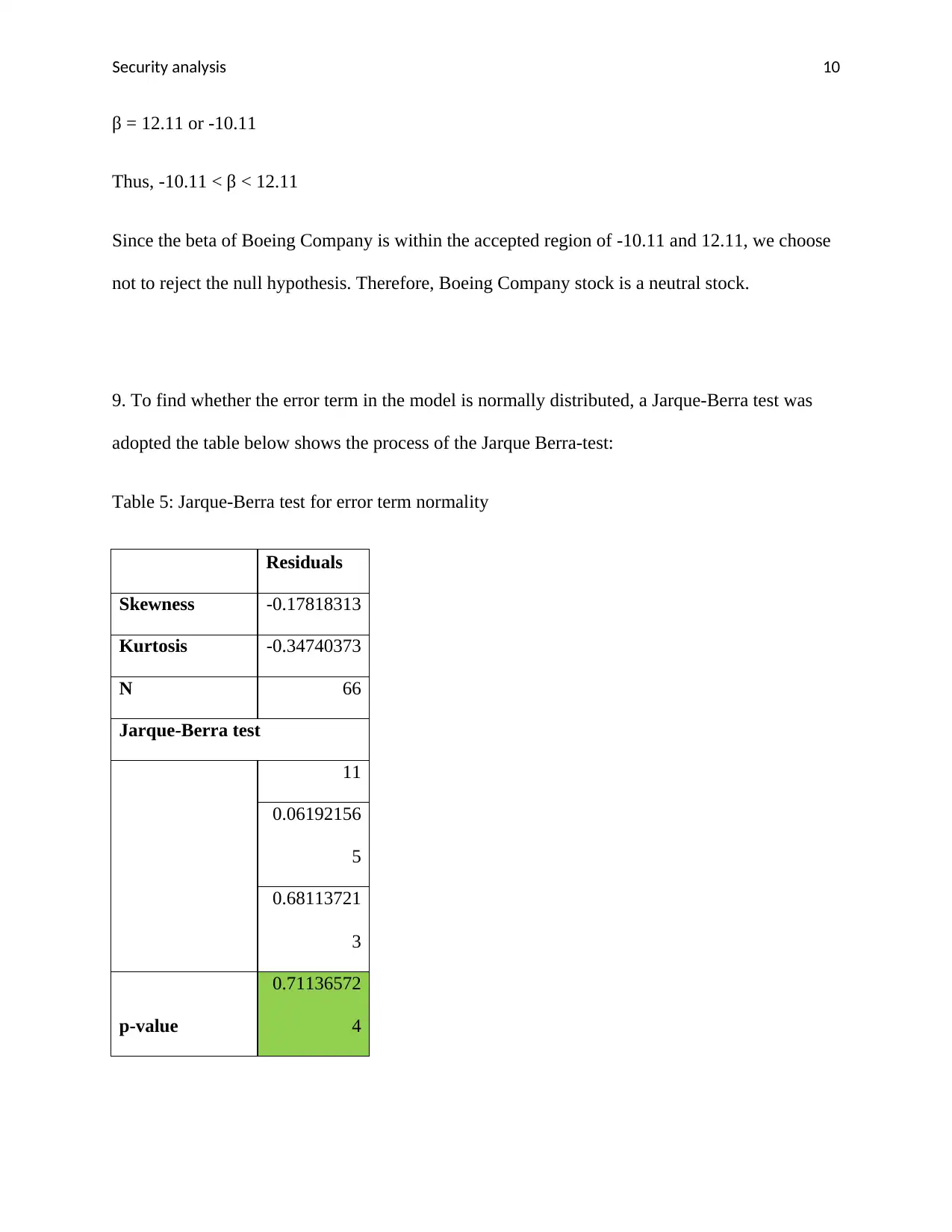
Security analysis 10
β = 12.11 or -10.11
Thus, -10.11 < β < 12.11
Since the beta of Boeing Company is within the accepted region of -10.11 and 12.11, we choose
not to reject the null hypothesis. Therefore, Boeing Company stock is a neutral stock.
9. To find whether the error term in the model is normally distributed, a Jarque-Berra test was
adopted the table below shows the process of the Jarque Berra-test:
Table 5: Jarque-Berra test for error term normality
Residuals
Skewness -0.17818313
Kurtosis -0.34740373
N 66
Jarque-Berra test
11
0.06192156
5
0.68113721
3
p-value
0.71136572
4
β = 12.11 or -10.11
Thus, -10.11 < β < 12.11
Since the beta of Boeing Company is within the accepted region of -10.11 and 12.11, we choose
not to reject the null hypothesis. Therefore, Boeing Company stock is a neutral stock.
9. To find whether the error term in the model is normally distributed, a Jarque-Berra test was
adopted the table below shows the process of the Jarque Berra-test:
Table 5: Jarque-Berra test for error term normality
Residuals
Skewness -0.17818313
Kurtosis -0.34740373
N 66
Jarque-Berra test
11
0.06192156
5
0.68113721
3
p-value
0.71136572
4
Paraphrase This Document
Need a fresh take? Get an instant paraphrase of this document with our AI Paraphraser
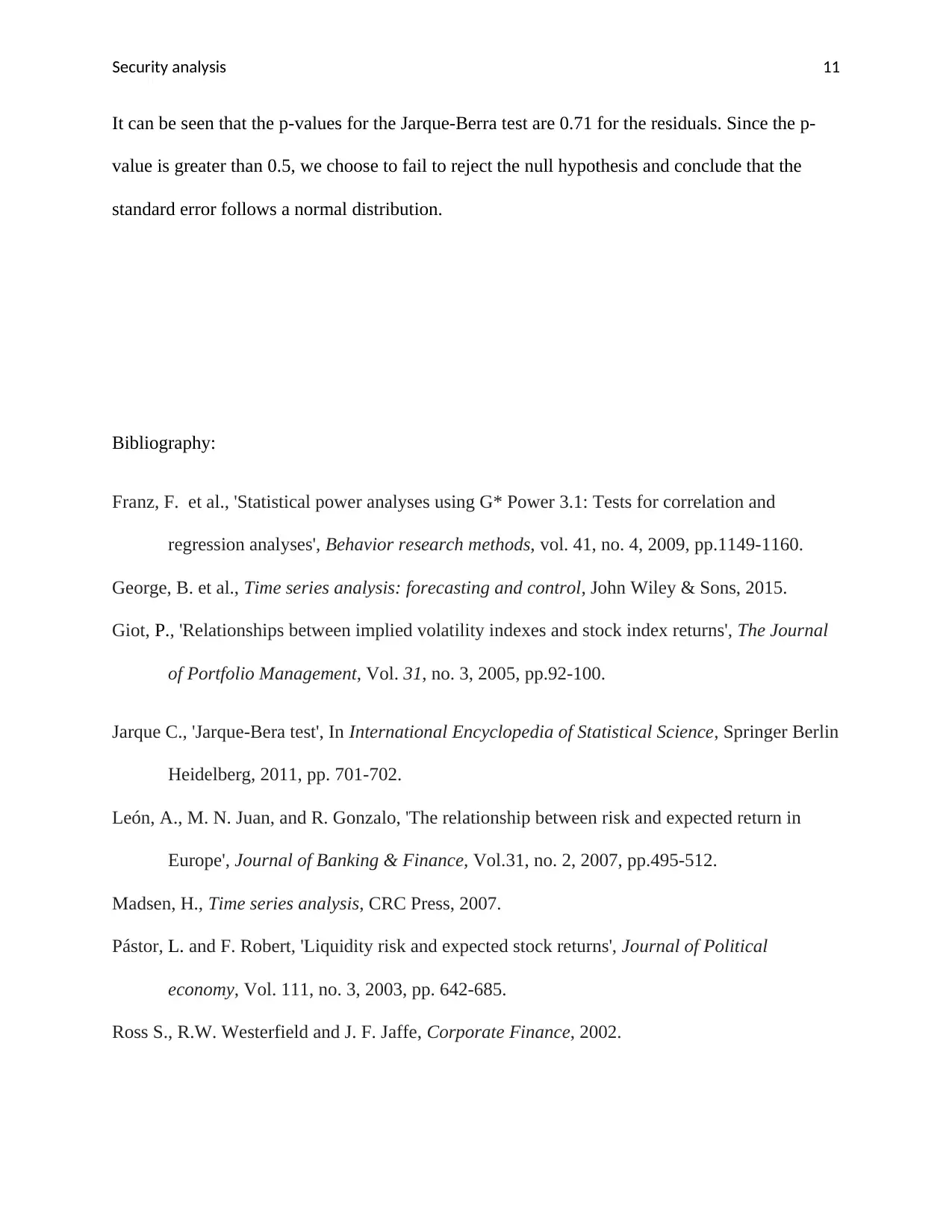
Security analysis 11
It can be seen that the p-values for the Jarque-Berra test are 0.71 for the residuals. Since the p-
value is greater than 0.5, we choose to fail to reject the null hypothesis and conclude that the
standard error follows a normal distribution.
Bibliography:
Franz, F. et al., 'Statistical power analyses using G* Power 3.1: Tests for correlation and
regression analyses', Behavior research methods, vol. 41, no. 4, 2009, pp.1149-1160.
George, B. et al., Time series analysis: forecasting and control, John Wiley & Sons, 2015.
Giot, P., 'Relationships between implied volatility indexes and stock index returns', The Journal
of Portfolio Management, Vol. 31, no. 3, 2005, pp.92-100.
Jarque C., 'Jarque-Bera test', In International Encyclopedia of Statistical Science, Springer Berlin
Heidelberg, 2011, pp. 701-702.
León, A., M. N. Juan, and R. Gonzalo, 'The relationship between risk and expected return in
Europe', Journal of Banking & Finance, Vol.31, no. 2, 2007, pp.495-512.
Madsen, H., Time series analysis, CRC Press, 2007.
Pástor, L. and F. Robert, 'Liquidity risk and expected stock returns', Journal of Political
economy, Vol. 111, no. 3, 2003, pp. 642-685.
Ross S., R.W. Westerfield and J. F. Jaffe, Corporate Finance, 2002.
It can be seen that the p-values for the Jarque-Berra test are 0.71 for the residuals. Since the p-
value is greater than 0.5, we choose to fail to reject the null hypothesis and conclude that the
standard error follows a normal distribution.
Bibliography:
Franz, F. et al., 'Statistical power analyses using G* Power 3.1: Tests for correlation and
regression analyses', Behavior research methods, vol. 41, no. 4, 2009, pp.1149-1160.
George, B. et al., Time series analysis: forecasting and control, John Wiley & Sons, 2015.
Giot, P., 'Relationships between implied volatility indexes and stock index returns', The Journal
of Portfolio Management, Vol. 31, no. 3, 2005, pp.92-100.
Jarque C., 'Jarque-Bera test', In International Encyclopedia of Statistical Science, Springer Berlin
Heidelberg, 2011, pp. 701-702.
León, A., M. N. Juan, and R. Gonzalo, 'The relationship between risk and expected return in
Europe', Journal of Banking & Finance, Vol.31, no. 2, 2007, pp.495-512.
Madsen, H., Time series analysis, CRC Press, 2007.
Pástor, L. and F. Robert, 'Liquidity risk and expected stock returns', Journal of Political
economy, Vol. 111, no. 3, 2003, pp. 642-685.
Ross S., R.W. Westerfield and J. F. Jaffe, Corporate Finance, 2002.
1 out of 11
Related Documents
Your All-in-One AI-Powered Toolkit for Academic Success.
+13062052269
info@desklib.com
Available 24*7 on WhatsApp / Email
![[object Object]](/_next/static/media/star-bottom.7253800d.svg)
Unlock your academic potential
© 2024 | Zucol Services PVT LTD | All rights reserved.





